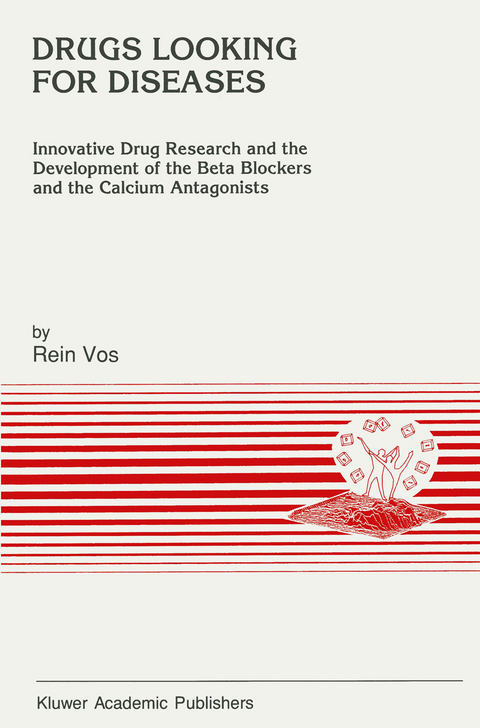
Drugs Looking for Diseases
Springer (Verlag)
978-94-010-5689-2 (ISBN)
We all know how much time, effort and money it takes to develop a new drug. Hundreds of chemical compounds have to be synthesized and thousands of different activities in biology, physiology, pharmacology, clinical investigation, management and marketing have to be initiated and coordinated. Each new drug starts a voyage of discovery through an unmapped terrain which is shrouded in mist and beset by pitfalls, as Dr. Rein Vos puts it in his absorbing inside story of the development of the beta-adrenoceptor blocking agents and the calcium antagonists. Indeed we know, for example, how long it took before the theory of Ahlquist of the alpha and beta adrenergic receptors was widely accepted. Similarly, it suffices to memorize shortly the difficulty of expanding the new concept of calcium antagonism through the national German boundaries into the world. This shows how laborious and complex pharmaceutical progress is, and we all will benefit from a deeper understanding of the process of innovative drug research.
1. The controlled clinical trial — a model for the intricate relationships between clinical medicine and drug research.- 1.1. Introduction.- 1.2. The evolution of the controlled clinical trial (CCT).- 1.3 The implementation of the controlled clinical trial in drug research.- 1.4. Criticism of the classical view of the controlled clinical trial.- 1.5. Conclusions.- 2. The architecture of drug discovery.- 2.1. Introduction.- 1. The discovery process.- 2.2. Current views of drug discovery.- 2.3. Scientific discovery from the viewpoint of cognitive science.- 2.4. The drug discovery process revisited.- 2. The representation of knowledge about drugs and diseases.- 2.5. An epistemological analysis of the concept of drug and disease profiles.- 3. A set-theoretical model of drug discovery.- 2.6. A definition of the concept of profile in terms of set theory.- 2.7. The drug discovery process — a set-theoretical model.- 3.Experimental and therapeutic profiling in drug innovation: the early history of the beta blockers.- 3.1. Introduction.- 3.2. Historical overview of the development of the beta blockers.- 3.3. From Dale to Ahlquist: a new methodology in pharmacology.- 3.4. Change in the concepts of agonist and antagonist.- 3.5. Experimental and therapeutic profiling in drug innovation.- 3.6. Conclusions.- 4. Industrial research and beta blockade.- 4.1. Introduction.- 4.2. Beta blocker research at Imperial Chemical Industries (ICI).- 4.3. The beta blocker project of Eli Lilly & Co..- 4.4. The beta blocker project of Mead Johnson.- 4.5. The beta blocker project of AB Hässle.- 4.6. The beta blocker project at CIBA.- 4.7. Conclusions.- 5. Verapamil: dying drug or sleeping beauty?.- 5.1 Introduction.- 5.2 The early history of verapamil.- 5.3 Verapamil: a coronary vasodilator?.- 5.4Verapamil: a beta blocker?.- 5.5. Verapamil: a calcium antagonist! — The elucidation of verapamil’s mechanism of action by Fleckenstein.- 5.6. Citation analysis of the concept of calcium antagonism elaborated by Fleckenstein.- 5.7. The application of the theory of drug and disease profiles.- 5.8. Conclusions.- 6. Metamorphosis of a disease — Profiles of angina pectoris in Anglo-American medicine.- 6.1. Introduction.- 6.2. Anglo-American medical views of angina pectoris.- 6.3. Disease profiles of angina pectoris in Anglo-American medicine: cognitive dimensions..- 6.4. Disease profiles of angina pectoris in Anglo-American medicine: social dimensions.- 6.5. Anti-anginal drugs in the light of changing views of angina pectoris.- 6.6. Conclusions.- 7. Targeting in drug research and the medical scene The beta blocker project at Boehringer against the background of different views in German and Anglo-American medicine.- 7.1 Introduction.- 1. The medical scene — different views in German and Anglo-American medicine.- 2. The influence of medical perceptions on targeting in drug research.- 7.3. The beta blocker project at Boehringer Ingelheim.- 3. Application of the theory of drug and disease profile.- 7.4. Theoretical analysis of the Boehringer project against the background of medical views about angina pectoris and heart failure.- 7.5. Conclusions.- 8.Search processes, profiles and therapeutic practice in drug discovery.- 8.1. Introduction.- 8.2. The search process in drug discovery.- 8.3. Evaluation of the theory of drug discovery.- 8.4. Practice - the contribution to drug discovery.- 8.5. Conclusions.- 9. The enigma of drug discovery.- Notes.- 1.- 2.- 3.- 4.- 5.- 6.- 7.- 8.- 9.- References.- Appendices.- Appendix I. The ranking order aspect of the concept ofprofile.- Appendix II. Bibliometrical analysis of the impact of Fleckenstein’s concept of calcium antagonism.- Appendix III. Bibliometrical analysis of Charlier’s “Antianginal Drugs”.- Name Index.
| Reihe/Serie | Developments in Cardiovascular Medicine ; 120 |
|---|---|
| Zusatzinfo | XXX, 381 p. |
| Verlagsort | Dordrecht |
| Sprache | englisch |
| Maße | 155 x 235 mm |
| Themenwelt | Geisteswissenschaften ► Philosophie |
| Medizinische Fachgebiete ► Innere Medizin ► Kardiologie / Angiologie | |
| Medizin / Pharmazie ► Medizinische Fachgebiete ► Medizinethik | |
| Studium ► Querschnittsbereiche ► Geschichte / Ethik der Medizin | |
| ISBN-10 | 94-010-5689-7 / 9401056897 |
| ISBN-13 | 978-94-010-5689-2 / 9789401056892 |
| Zustand | Neuware |
| Haben Sie eine Frage zum Produkt? |
aus dem Bereich


